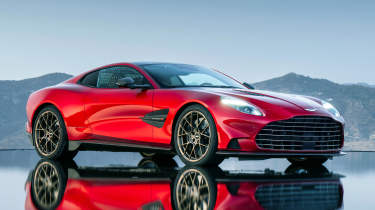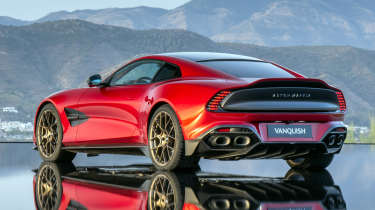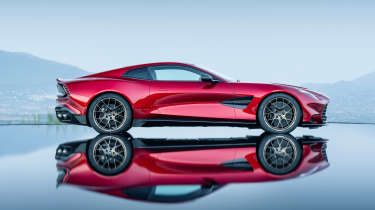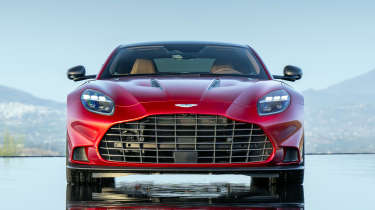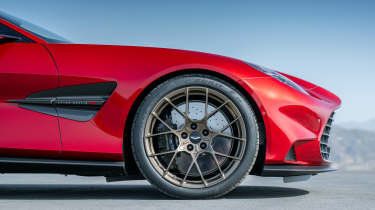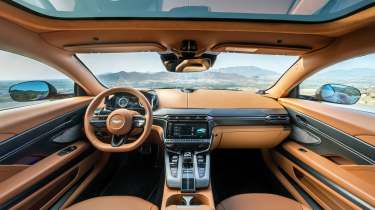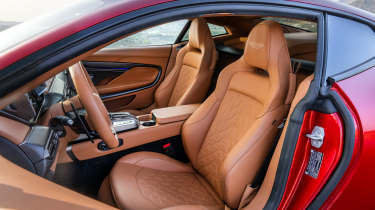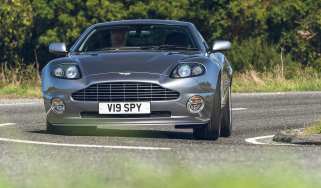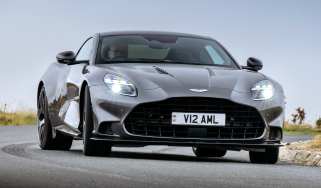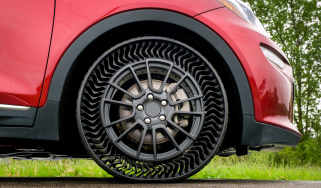The new Aston Martin Vanquish is an 824bhp, £333k Ferrari 12Cilindri rival
Aston brings back the Vanquish name for its flagship GT, with a stunning new look and a twin-turbocharged V12
The Lawrence Stroll era of Aston Martins has seen the company shift towards a new brand ethos that brings dynamic ability to the forefront of its priorities. The DB12 and new Vantage were the first new models designed with this in mind, and both cars mark a clear step forward in terms of performance and aggression, as well as onboard tech.
Now there’s the Vanquish – the crown jewel of the new era of Astons, packing an 824bhp V12 to take the fight to the Ferrari 12Cilindri. With attention lavished on its powertrain, platform and chassis, it shifts into a whole new realm of performance compared to the V8-only DB12.
‘The journey with what we call our new generation sports cars started four years ago,’ explains Simon Newton, Aston’s director of vehicle performance. ‘We were looking at all the different technologies that we wanted to add to our sports car platform, to bring the cars up to a class-leading levels of dynamics and performance, yet still being true Aston Martins. The DB12 and Vantage have achieved what we wanted, and the Vanquish is even more special because of the V12 powertrain.’
Clearly, double-digit cylinder counts are what buyers at this level (around £333,000, if you’re asking) want these days. Ferrari has given the V12 another lease of life with the 12Cilindri, so too Lamborghini with its Revuelto. Further up the food chain there’s the GMA T.50, the Bugatti Tourbillon and Aston’s own Valkyrie, all of which pull in customers through the sounds and sensations that can only be delivered by an exquisite combustion engine. Fleet emissions regulations mean that production of the Vanquish will be limited to 1000 units per year, but there’s a sense that Aston has been able to push more boundaries than it did with the DBS it replaces, to make the new car feel like a standalone product.
Newton describes the engine as ‘literally ballistic’. It’s a new-generation 5.2-litre twin-turbo unit that’s a heavy development of what was found in the DBS, with a strengthened block and conrods, new heads, cams and turbochargers, among other changes. The combustion charges are now 15 per cent higher than the DBS’s engine (necessitating the stronger componentry) and the result is Aston’s most powerful series-production V12 yet – one with a higher specific output than even the Valkyrie’s Cosworth-developed motor. Peak power of 824bhp comes in at 6500rpm, with maximum torque of 738lb ft spread between 2500 and 5000rpm. That gives a 0-62mph time of 3.3sec and a top speed of 214mph.
Drivability has been a key focus as well as raw power, so the new turbos have less inertia to reduce lag and spin 15 per cent faster. Response is further improved by what Aston calls a ‘Boost Reserve’ function. Effectively, the system builds up excess boost pressure under part throttle by controlling the throttle flap position and turbo wastegate, delivering a more immediate hit when you get hard on the power. It’s a clean engine too (relatively speaking, of course), with 30 per cent more efficiency in the combustion chamber and more stable spark propagation helping it to reach Euro 6 emissions standards.
Noise regulations are a trickier subject. The Vanquish meets the current standards and should be compliant into the future, but the muffling effect of gas particulate filters means that Aston has been forced to channel some synthesised engine noise through the speakers. The noise is at least designed to sound as authentic as possible and complements the natural tunes from the intake and exhaust, which is available in either stainless steel or titanium (the latter gives a racier, higher-pitched note and saves 10.5kg).
The engine is linked to a rear-mounted eight-speed ZF auto via a carbon prop shaft. In the DBS, the diff’s durability was a limiting factor for the maximum torque output, but the Vanquish has gained a stronger final drive and fine-tuned torque mapping to eliminate the issue. The diff itself is electronically controlled and can go from fully open to locked in 135 milliseconds – at low speeds it’s more open to aid agility, and it tightens up at higher speeds to make the car more stable. Also aiding stability and turn-in is the new ‘Corner Braking 2.0’ set-up, which uses the Vanquish’s dynamic control systems to fine-tune the car’s balance when trail-braking into a corner.
Compared to the DBS, the Vanquish has much tighter integration between its chassis systems, with the e-diff linked up to the ESP system and adaptive Bilstein DTX dampers. The electronics are hard to get your head around, with an array of systems such as Brake Slip Control, Integrated Vehicle Control, Positive Torque Control and Integrated Vehicle Dynamics Estimation, but Aston says that they’ve been designed to work seamlessly in the background to massage more performance and predictability from the car, rather than guiding you with firm grip. By measuring the car’s attitude using a six-axis accelerometer, as well as wheel speed, steering and pedal-position sensors, the systems can estimate the grip levels at the tyres and make fine adjustments in the background, supposedly without disturbing your inputs.
As a driver, you only need to bother with three drive modes – GT, Sport and Sport+ – and four ESP settings: On, Wet, Track and Off. GT is a do-it-all setting with the lightest steering efforts, most relaxed powertrain calibration and damping rates, while Sport and Sport+ ramp these up. The e-diff and ESP calibrations change as you switch through the modes, too, and there’s an Individual mode to mix and match as you prefer. The ESP, meanwhile, has been calibrated to improve both safety and performance – Aston says that even professional drivers are quicker when using Wet mode in the rain.
On top of this there’s adaptive traction control, which allows you to determine the level of wheelspin and rate of oversteer. In the Vantage we found this system to be intuitive and natural-feeling in its subtle catching of slides. What you won’t find in the Vanquish’s armoury of chassis tech is rear-wheel steering. ‘It’s a technology that we have evaluated at the start of development and along the way, but we’re trying to achieve a direct driver seat-to-rear contact patch connection,’ said Newton. ‘In our experience rear-steering dilutes that slightly. We didn’t want the weight penalty, and after getting the car set up right in the first place, there wasn’t a need to add it.’
Although these chassis electronics have been designed to make the Vanquish more friendly, it should still have the wild nature that made the DBS so addictive. ‘Stepping out of a DBS 770 Ultimate and into this, you’ll notice that this is much faster, which is ridiculous because the 770 is very fast,’ says Newton. ‘The damping is more sophisticated and the Vanquish has more bandwidth, and it’s more linear in the way it responds. The old car might have been more excitable at all speeds whereas this is more secure at high speed, but free to yaw at low speed’.
Aston’s bonded aluminium structure (as used in the Vantage and DB12) has been adapted for use in the Vanquish, with an 80mm longer wheelbase and extensive strengthening measures. There's a stiffer engine cross brace, new undertrays and a revised front cross member, and the chassis is more rigid between the rear suspension towers. The result is a massive 75 per cent increase in lateral stiffness compared with the 770 Ultimate, providing a stronger base to tune the new dampers. The steering column is fixed by non-isolated mounts for a more direct feel (as in the last-of-the-line DBS), and the stiffness of the suspension bushes has been optimised to filter out more road harshness without sacrificing precision.
This kind of fine-tuning extends to the tyres, which are Pirelli P Zeros with a unique compound and construction for the Vanquish. The Vantage and DB12 use Michelins, but Newton says the Pirellis suit the character of the Vanquish better. ‘We like the traction from these tyres, and they have a nice amount of inherent damping in the sidewall. They also have an efficient noise reduction system which suits this car.’ There’s plenty of rubber on the ground with 275-width fronts and 325 rears, wrapped around 21-inch forged alloys (lighter than those fitted to the DBS). The standard carbon-ceramic brakes comprise 410mm discs at the front and 360mm items at the back, saving 27kg in unsprung mass compared with a cast-iron set-up.
All this is wrapped up in a body that’s rippling with muscle. The Vanquish has real presence, partly because of its size (at 4.85m long it only just fits on the turntable inside the studio at Aston HQ) but mostly because there’s so much aggression in its proportions. The closer you look, the more intricacies you notice, from the concave front grille that gives a sharknose-style side profile, to the tight folds of carbonfibre that make up the bonnet vents. Move around to the rear and it’s radically different to the DB12, the sawn-off Kamm tail featuring a carbonfibre shield panel flanked by a line of blade-like LEDs for the tail lights. They look a little strange up close, almost like a temporary solution from an early-series prototype, but there’s absolutely no mistaking the Vanquish for another Aston Martin, which hasn’t always been the case with its V12 flagships.
‘One of the wonderful things about designing this car is the fact that this is the only one with a V12 engine,’ says Aston design director Miles Nurnberger. ‘It’s allowed us to build a unique product in a way that we perhaps couldn’t with the DBS. In some ways, you could say that the DBS was a variant of the DB11. I wouldn’t necessarily call this a new design language, but it’s a really strong progression that we’ve had the opportunity to create with an all-new exterior’.
Every body panel aside from the front and rear bumpers is made from carbonfibre, which not only saves weight (the Vanquish comes in 1774kg without fluids) but allows for more complex shapes than conventional steel pressings. Despite being the fastest series-production Aston ever, the Vanquish isn’t a downforce monster, but its bodywork has been formed to reduce lift and stabilise the car at speed. A full-width carbon rear diffuser contributes to this, as well as a lip spoiler integrated into the bootlid. Cooling has been improved over the 770 Ultimate too, with the new grille providing a 13 per cent larger surface area to feed more air to the V12, and outer vents in the bumper directing flow towards the front arches to cool the brakes.
Despite its extra length, the Vanquish is a ‘2+0’, doing away with the DB12’s emergency rear seats in favour of an area to store fitted luggage. Everything inside is beautifully crafted, and as with the DB12 and Vantage, it feels like Aston has agonised over the details to a much greater extent than it did with the previous-generation cars. Even the cup holders are leather lined.
There are obvious elements taken from the DB12, but with a lower centre console and a panoramic glass roof (a first for a V12 Aston – a carbon roof is optional), the Vanquish has a more open and airy feel from the driver’s seat. Like all the most special cars, the architecture is unconventional in some ways – the dashboard is short and slopes sharply down from the scuttle, the windscreen has an aggressive angle of attack, and you’re positioned a long, long way from the nose. Judging where it stops will be guesswork, we imagine.
The HMI is Aston’s own system that first appeared on the DB12, developed in-house and featuring 4G connectivity, wireless Apple CarPlay and remote smartphone connectivity via an Aston Martin app. The interface consists of a 10.25-inch digital dial pack behind the steering wheel and a dash-mounted touchscreen of the same size, but there’s still an array of physical switchgear for quick access to general controls. ‘It was very important for us to allow you to interact with physical buttons,’ says Nurnberger. ‘You can get to the temperature, volume and seat controls very quickly. There isn’t a lag that will distract you from the road.’
Given this emphasis on analogue elements as well as digital, we wondered whether Aston had considered following Bugatti and giving the Vanquish an intricate physical dial pack rather than a screen. ‘We did consider it,’ admits Nurnberger, ‘but we decided that for this car the digital solution offered what we wanted. It’s something interesting we’re looking at for the next generation. Three or four years ago there was a relentless need for more screens in cars, but I think a lot of people have now discovered that the grass wasn’t necessarily greener in this respect.’
Order books for the Vanquish are now open, with the first examples arriving in customer’s hands in the last quarter of this year. At £333,000 it is a chunk more expensive than the DBS was near the end of its life (and £19k more than the 770 Ultimate), but you could argue that none of its predecessors since the original Vanquish have been created with this level of freedom. In its design, specification and engineering detail, it feels like the Ferrari 12Cilindri rival Aston Martin wants it to be. We’ll soon find out whether the driving experience backs that up.

